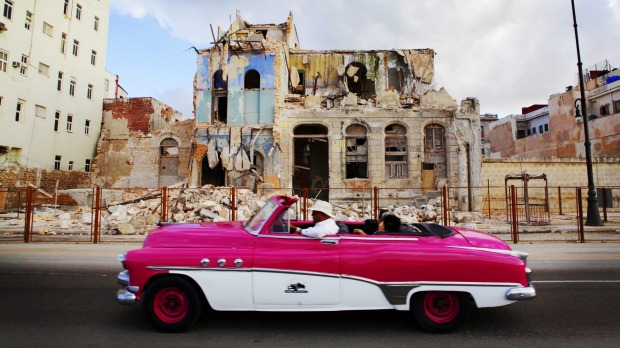
Where to go for this year's family holiday?
Cuba! My wife Mandy says with wide eyes. "We have to beat Ronald McDonald there," (Guantanamo's McDonald's is only open to the base's personnel and is not on our itinerary).
So as our children, Amelie 12 and Jack six, spin the globe to see where it is, we plot our course to the mysterious Caribbean island.
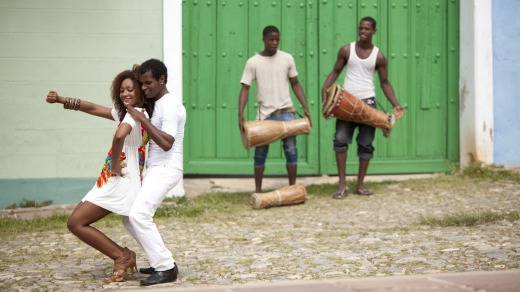
The pain of 30-hours travel via the United States and Mexico fades when we meet Monica, our tour guide for the next two weeks.
Monica is friendly, beautiful and intelligent. She is both optimistic and uncertain about the future — she is modern-day Cuba.
We meet in the lounge of Hotel Presidente, a 1920s art deco gem in the Vedado district of central Havana. Monica's warm Cuban smile instantly connects with Amelie and Jack.
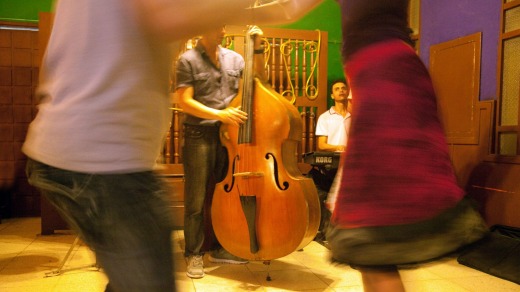
Like most Cubans Monica, 29, is highly educated — a computer programmer and language teacher. She is also an excellent salsa dancer.
While Cubans struggle for many of the modern conveniences most of us take for granted — they never have to worry about a good education.
In the final letter revolutionary Che Guevara wrote to his close friend and Cuban president Fidel Castro in 1965, he said leaving nothing to his wife and children did not worry him because the state would provide. Almost six decades later that confidence has proved prophetic with Cuba boasting one of the highest literacy rates in the world (99.8 per cent) and a free, world-class, health system.
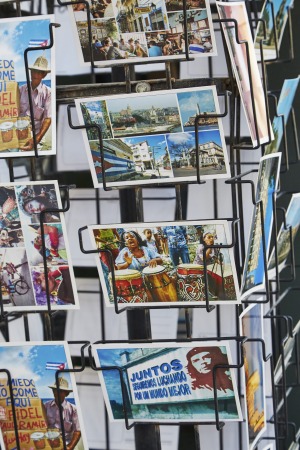
Monica was born long after the victorious Castro and his revolutionaries swept into Havana — socialist Cuba is all she knows.
"Cuba is quickly changing," she tells us. "And your family, like many others, are rushing to visit Cuba before Starbucks arrives and the old cars disappear."
The middle of the year is normally low season but not this year. Tourists from countries around the globe are racing to beat the Americans. Cuba and the United States have re-opened embassies, diplomatic relations are thawing, John Kerry this year became the first US Secretary Of State in half a century to visit Havana and millions of American tourists will soon follow.
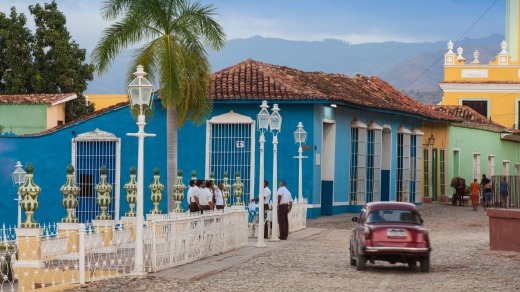
Cubans are painting their homes and turning them into Casas — a Cuban version of bed and breakfast. They are opening paladares (privately run restaurants) and other businesses — the curtains are being ripped down. Cuba is a living time capsule that has just been smashed open.
But the ubiquitous vintage cars and lack of basic internet tell you this is still a unique country.
"This is the world's biggest museum," one German tourist quips.
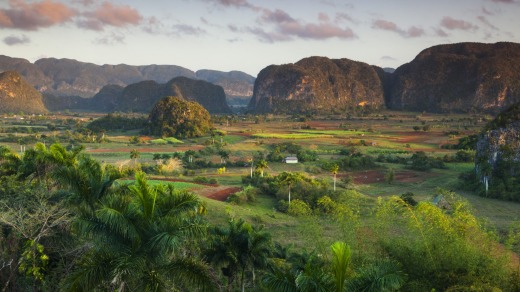
It was only seven years ago Cubans were first allowed to own mobile phones or stay in hotels in their own country. It is only in the last four years Cubans have been able to sell cars and buy and sell homes. Only in the last three years Cubans could travel overseas. While we were there the cost of the internet card halved from $4 an hour to $2 — a big change given the average local income is just $40 a month.
And these eleven million people are just 145 kilometres off the coast of the United States.
The solitude engendered a sense of camaraderie among Cubans, taxi drivers follow you into the hotel to prop up at the bar and chew the fat with staff. The community is connected like a big family, a shared experience and understanding. This makes our family feel safe and welcome.
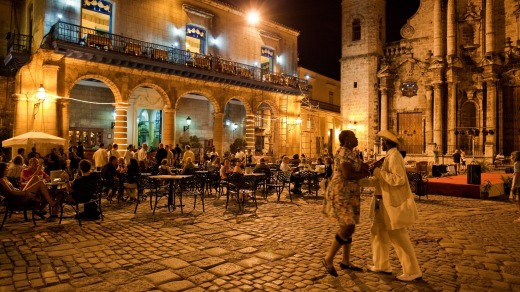
Despite the rapid changes, Cuba remains an overwhelmingly socialist country, Monica explains. With the low government average wage few can afford cars, the popular American vintage cars are recycled through generations and if one does hit the market it carries a price tag of about $30,000. Cuba's cars are a political chronology. The lavish American Fords and Chevrolets of the halcyon 1950s when Havana was the original sin city for colourful Americans, the Soviet-era Ladas from the Communist bloc days and the more recent arrival of cheaper Chinese models.
The eclectic mix of cars still add up to not many. Congestion is non existent if you don't count the horse-drawn carts and bikes.
Large advertising is also conspicuously absent, no big Coca Cola ads or golden archers here.
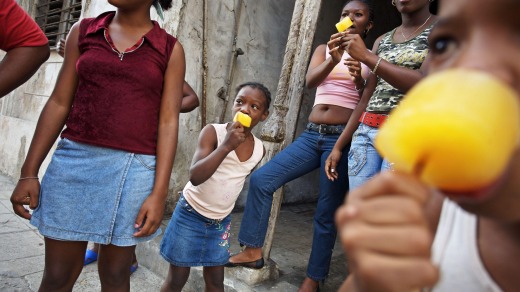
We hear many "mother in law" jokes as we travel around and socialism is to blame. House prices are beyond what most Cubans can afford so young couples are living with the daughter's parents for longer than is healthy …. there is a very high rate of divorce of more than 50 per cent .
Havana apartments change hands so rarely people gather to take pictures of a 'for sale' sign.
What next for this Caribbean family that few have visited for half a century. What comes after the Castros? (Fidel is old and ill, his brother Rahul who is now running the place is 84).

Monica shrugs her shoulder, "that is the big unknown".
Enough of the history lesson, time to explore.
We climb into a purple 1955 Chevrolet Bel Air Convertible and cruise the Malecon sea drive, Havana's spectacular coastal road flanked by locals fishing, historic Spanish forts such as El Morro (captured by the British for a while in 1762) and the Hotel Nacional, Cuba's most famous hotel where Frank Sinatra played and Winston Churchill stayed, on the other.
Over there is Havana's unique Chinatown that sells a good lasagna — there are no Chinese, nearly all left after the 1959 revolution.
And there is a giant image of Che Guevara stretching the height of an office tower.
Amelie and Jack revel in the expansive backseat of the Cadillac in the hot Havana air, feeling like rock stars.
You don't need a cadillac to explore the best of the World Heritage listed Old Havana (La Habana Vieja), with its historic forts, car-free cobblestone streets, hidden arcades, discreet courtyards and striking plazas.
We walk the 2 kilometres through the old streets linking the four main plazas, visit Hemingway's favourite haunts, and even have time to buy some souvenirs at the central park market, in an hour.
As well as their historic beauty and the opportunity for another mojito, these Spanish plazas are also a honey pot for hawkers — before you know it someone will be planting a kiss, shoving a cigar in your mouth and hitting you up. Capitalism is catching on.
They use two currencies in Cuba, the Cuban convertibles, which tourists use and is one-to-one with the US dollar and a Cuban peso which is about 25 to the US dollar. Don't worry about trying to use the local Cuban peso, you will be charged in convertibles regardless.
At night we catch a Buena Vista Social Club show in the old city that includes some original band members from the 1950s — those under 60 can definitely find a more exciting night out in Havana.
We jump in a minibus, and Pedro, our driver for the next eight days, heads west to the town of Vinales and the heart of Cuba's famous tobacco industry. The valley of Vinales is lined with verdant farmland where mangos and avocados drip from trees surrounded by fields of coffee beans, sugar cane, bananas, and of course tobacco. The valley is flanked by striking limestone cliffs and stunning vistas.
We head off on a three-hour walking tour through the surrounding farms and taste the fruit straight off the trees and visit a third generation tobacco farmer and his wife who roll a cigar for us. Eat your heart out Joe Hockey.
Back in town a couple of local farmers are riding through the main streets on horses — one is talking on a mobile phone. This is quintessential Cuba at the crossroads.
The day is topped with dinner at a nearby "eco farm" overlooking town. The farm avoids chemicals and uses tobacco leaf and rabbit poo as natural pesticides and fertiliser. Another crushed ice mojito, some slow cooked lamb and sunset over the Vinales valley. Magic.
While Cuba is not known for its culinary delights, the meals are ample with plenty of rice, beans, chicken and fish. There are also plenty of fries if the kids are fussy.
We cruise along the main highway east to the Bay of Pigs and the small town of Playa Giron now a popular beach destination for Cubans. In 1961 it was the scene of an ill-considered CIA invasion using 1400 Cuban expats who sailed from Nicaragua. The mercenary force was not welcomed and the invasion spectacularly failed.
Amelie and Jack find the history and propaganda interesting and a little confusing. The museum at Playa Giron is also a little gruesome with the uniforms of fallen soldiers punctured with holes.
The children ask the obvious question no one could answer. Where are the pigs?
Playa Giron is also a popular scuba diving and snorkelling destination with a beautiful coral reef right to the shore. At $30 each, for a dive, we can hardly resist. Even our 12-year-old daughter Amelie, who had never dived before, has a go. We swim in clear Caribbean waters and even spot one of the monster lobster popular on Cuban dinner tables.
We keep heading east to the colonial masterpiece Trinidad, declared a world heritage site by UNESCO in 1988 and one of Cuba's most stunning cities.
Trinidad's economic boom occurred in the 1800s on the back of huge sugar plantations and slave labour. The Spanish sugar barons financed a classic city with the central square — Plaza Mayor — surrounded by grand mansions that were the city addresses of the plantation owners.
One of the mansions, Casa Cantero, is now the town's' central museum. We climb to the top of the mansion's tower for the stunning views of Trinidad. Best not to do the climb in the middle of the afternoon heat as we did. Trinidad in July is very hot, even by Cuba's standards.
Casa Cantero was a symbol of status and power and the front doors are so big they look like they were built for giants. Just outside Trinidad we visit another tower at a former sugar plantation, the Manaca-Iznaga Tower. The 19th-century 45-metre tower was thought to have once been the tallest structure in Cuba. They tell us the striking structure had a sinister purpose — to watch over the plantation's slaves with 360 degree views.
The evidence of endless human labour is everywhere.
Trinidad was built stone by stone. Nearly every street is lined with millions of rocks from a nearby stream — the streets are living riverbeds.
At night, the city which closes to the afternoon heat, begins to flow. Doors and windows fling open, locals appear, music and laughter drifts down the ancient streets. It is the essence of Cuba, this country is living proof you don't need money to have class.
Jack, Amelie and Monica try some salsa dancing near the city square. Mandy and I are not game to publicly demonstrate the fruits of our one-hour salsa lesson taken earlier in the trip, so sit sipping mojitos and smile at how happy the kids are.
For those with big kids, there is even a disco in a cave on a hill overlooking Trinidad.
Slowly around midnight we walk back to the casa, shoes off, barefoot on the warm river stones in the cool evening breeze and Jack hops across the stones like jumping across a creek.
Cuba's allure is this mix of history, heritage and friendly, fun locals. It's like a big outdoor classroom where we also learn about Jose Marti, Cuba's most famous revolutionary leader who was killed trying to liberate Cuba from Spain and of Benny More, Cuba's version of Elvis.
On the way back to Havana we visit the Che Guevara mausoleum in Santa Clara — this is where Guevara's body was sent in a national cavalcade after his remains were finally discovered in Bolivia in 1997. It is also where Guevara overturned a government army train to seize the key victory of the revolution in 1958.
Then it is time to indulge in some more stunning al fresco dining and soak up the music and hispanic rhythm in the old city of Havana one more time. The popular Cuban tune "guantanamera" is still hummed around our home.
There are tears when the two weeks in Cuba end and we say goodbye to Monica. For our family it's been more than a holiday but a glimpse of another world.
It showed the kids you don't need fastfood chains and iphone games to have fun on holiday and they may have even learnt a few things.
The world is catching up with Cuba — you don't have a moment to spare.
http://www.cubadiplomatica.cu/australia/EN/ConsularServices.aspx
http://www.intrepidtravel.com/au/cuba
http://www.lonelyplanet.com/cuba
http://smartraveller.gov.au/countries/cuba
It is almost impossible to fly direct from the United States to Cuba. We flew with Qantas to LAX, then connected through to Mexico City with AeroMexico then flew AeroMexico flight the next day for Havana. Qantas also fly Sydney to Dallas/Fort Worth six days a week and connect with codeshare partner American Airlines to Mexico.
Phone 13 13 13., see qantas.com.au
Virgin Australia has daily flights from Sydney and Brisbane into Los Angeles connecting with Delta Airlines onto Mexico City. See virginaustralia.com.
Australians citizens can apply for a tourist visa from the Cuban embassy in Canberra. http://www.cubadiplomatica.cu/australia/EN/Home.aspx
Havana
Hotel Nacional: Havana
Cuba's most famous hotel in an amazing location. Sip a mojito or three. Listen to the local musicians and watch the fisherman on the sea wall as the sun sets over the Gulf of Mexico. Rooms from about $350. See www.hotelnacional-cuba.com
Hotel El Presidente: Havana
An Art Deco gem dating to the 1920s. The terrace is another place to enjoy the local drinks and where local musicians also frequent. Rooms from $150 a night.
See www.en.roc-hotels.com.
For a great casa in old Havana try Reservas El Cristo 461, which is at 461 Brasil Street. Next door is one of the hip new bars springing up in Havana.
Vinales
You are spoilt for choice for top quality casas in Vinales. There are hundreds to choose from. Keep an eye out for air conditioning and a good outside seating area.
We stayed with a nice family at Casa Paez, one street back from the main street.
See www.casapartycular.com.
Cienfuegos
Hotel La Unión in Cienfuegos
Ideally located hotel in the heart of Cienfuegos with great pool and nice rooms. The rooftop bar offers a superb view at night. We went out for dinner. The restaurant is a little pricey. Rooms cost from $150 a night. See www.hotellaunion-cuba.com
Trinidad
Lost of tourists talk about the Iberostar Grand Hotel mainly because it is modern and has wifi. But you also have wifi at home so why not try another casa in the ancient backstreets of Trinidad. A night in a casa costs about 30 Cuban convertibles (CUCs). Which is about $50 Australian dollars.
Taking children to Cuba? Think about…
Small first aid kit with baby panadol, nausea and diarrhoea medicine, water purification tablets and something for earaches. We had a brush with a jellyfish and had a swimming ear infection that necessitated a doctors visit. We all also had upset tummies at different times. Cuba has excellent health services.
We always travel with a Lonely Planet guide for the maps, language tips and recommendations.
We played a lot of eye-spy — no Minecraft in Cuba.
Take some pens and a diary for children to write small diaries at the end of each day .
Cadillac convertible ride through Havana
The kids will feel like rock stars cruising in a Cadillac Bel Air through the back streets of Havana and stunning Malecon seaside drive. The driver will probably also let them sit at the steering wheel for a photo.
Snorkel and dive the caribbean at the Bay of Pigs with locals Ivette and Ronel.
Stay at the lovely Casa run by Ivette and then spend a morning diving and snorkelling with husband Ronel in the sparkling Caribbean at the Bay of Pigs. There is even some local animals to feed at the Casa and the Bay of Pigs museum to visit. See www.playagironcasa.com.
Salsa classes in Vinales
Embrace the local rhythm in the backstreets of Vinales with a personal salsa class. The kids pick up the movements quickly and don't dance like typical middle aged white guys (dad). Later you can show off your moves on the streets of Trinidad.
Indulge on the local ice cream in Cienfuegos
There is a reason this spot is always packed with locals. World-class ice cream at communist era prices. A bowl will set you back 17c. Better have two. See www.lonelyplanet.com/cuba.
Take a coco taxi in Havana.
From the moment the kids arrive in Havana they will want to ride in the coco or helmet taxi. They look like a yellow ball on wheels. See if you can negotiate a longer ride for some sightseeing.
See www.cubapop.com.
Stay at casa with some local kids:
Several homestays we visited were run by families with children. Your kids and their kids will be best friends in 10 mins, even with little Spanish. The kids will make friends and learn come local customs at the same time.